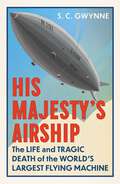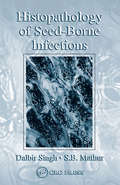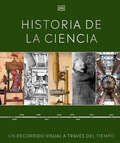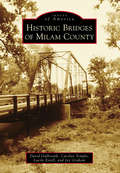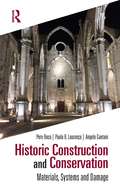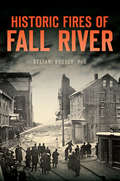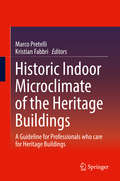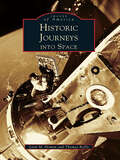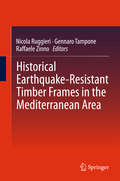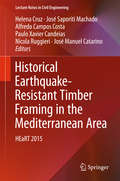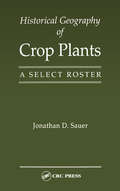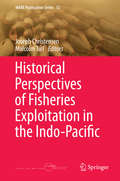- Table View
- List View
Himalayan Mobilities
by James P. Lassoie Robert E. BeazleyThe goals of this book are to update information on the effects of rural road development, both in Nepal and globally, explain the environmental, socioeconomic, and sociocultural impacts of expanding rural road networks in the Nepalese Himalaya, and to promote further studies on rural road development throughout the world based on studies and investigations performed in Nepal. Readers will learn about the history of rural road development, as well as the challenges to effectively design and construct rural roads and how these obstacles may be overcome. Chapter one offers a global review of road development, and both the positive and negative impacts of rural road implementation. Chapter two defines mobilities within the context of coupled social and ecological systems, specifically in the Nepalese Himalaya. Chapters three through five detail the environmental, socioeconomic, and sociocultural impacts expanding rural road networks through several case studies. The concluding chapter summarizes the findings of the book, discussing the need for interdisciplinary cooperation and collaboration to avoid negative consequences. This book will be of interest to teachers, researchers, policy makers, and development organizations.
Hip Prosthesis: CAD Modeling, Finite Element Analysis (FEA) and Compressive Load Testing (SpringerBriefs in Applied Sciences and Technology)
by Solehuddin Shuib Najwa Syakirah Hamizan Amir Radzi Ab GhaniThis book highlights the critical challenge of improving the design and performance of hip implants, which are essential for enhancing patient outcomes in hip replacement surgeries. The book focuses on utilizing Finite Element Analysis (FEA) to optimize implant designs, ensuring they can withstand complex mechanical loads and reduce the risk of failure. It is hoped that readers will gain a deeper understanding of the significance of implant design and the role of FEA in predicting and enhancing implant performance, ultimately leading to better, more durable solutions in orthopedic surgeries.
His Majesty's Airship: The Life and Tragic Death of the World's Largest Flying Machine
by S.C. GwynneWhen the R101 first took to the skies, she was the largest aircraft ever to fly. What followed was a tragic finale to a tale of human folly on a grand scale. 'I loved every page of this book.' THE TIMES, BEST HISTORY BOOKS OF 2023 In 1929, the R101 was the largest object ever to take to the air. It was meant to dazzle the world with cutting-edge technology and awesome size. Better than a plane, more luxurious than an ocean liner, the R101 would connect the furthest reaches of the British Empire, tying together far-flung dominions at a time when imperial bonds were fraying. It was, however, not to be. The spectacular crash of the British airship R101 in 1930 changed the world of aviation forever. Most have heard of the fiery crash of the Hindenburg, a German ship that went down in New Jersey seven years later. But the story of R101 and its forty-eight victims has largely been forgotten. His Majesty&’s Airship recounts the epic narrative of the ill-fated airship and her eccentric champion, Christopher Thomson. S. C. Gwynne brings to life a lost world of aviators driven by ambition, and killed by hubris.
Histopathology of Seed-Borne Infections
by Dalbir Singh S. B. MathurHistopathology of Seed-Borne Infections is the first book to provide comprehensive coverage of seed infection and disease. It includes an up-to-date account on the development and structure of seed, pointing out the structural variations in seeds of the plant families to which most crop plants belong. The text presents techniques and advice for his
Historia de la ciencia (Timelines of Science): Un recorrido visual a través del tiempo
by DKExplora el mundo de la ciencia como nunca antes en esta guía profusamente ilustrada.La historia de la humanidad ha avanzado gracias a los descubrimientos científicos. Desde que nuestros antepasados ??aprendieron a usar herramientas y fuego hasta los avances modernos que han dado forma al mundo en el que vivimos, la ciencia ha definido nuestra historia a lo largo de miles de años. Con bellas ilustraciones y textos claros y fáciles de leer, 'Historia de la ciencia' recorre la historia de la ciencia en todo el mundo y profundiza en la historia de las ideas, prácticas y progresos científicos. Con un enfoque visual y accesible único, este libro muestra como nunca antes cómo se originaron las ideas científicas clave y cómo han dado forma a nuestras vidas.Discover the world of science as never before in this richly illustrated guide.The history of humankind has been driven by scientific discovery. From our distant ancestors learning to use tools and fire for the first time, to the modern breakthroughs that have shaped the world we live in today, science has defined the story of humans for thousands of years. Using beautiful illustrations and clear, easy-to-read text, Timelines of Science explains the history of science as it unfolded around the world, and delves into the story of scientific ideas, practice, and progress one step at a time. Offering a uniquely accessible and visual approach, this book shows as never before where scientific ideas came from and how they have shaped all of our lives.
Historic Bridges of Milam County (Images of America)
by Lucile Estell Carolyn Temple David Galbreath Joy GrahamMilam County, located in the heart of Central Texas, is home to 18 historic bridges that were constructed through the years to accommodate the growth of the county. One bridge, Worley Bridge, has been fully restored in a cooperative effort between Milam County and the Texas Department of Transportation (TXDOT). TXDOT is an important partner in the preservation of these historic structures. Memories of some bridges will be preserved in a bridge park, which is being constructed in Rockdale. Other bridges simply stand in mute testimony to the passing of time and the changing of human needs and habits. This book tells the story of these bridges and their important role in our history. It provides knowledge and understanding of these structures.
Historic Bridges: Evaluation, Preservation, and Management
by Hojjat AdeliExplore Historic Bridge Design through the Perspective of Modern EngineeringHistoric Bridges:Evaluation, Preservation, and Management provides both an admiring and a technical account of bridge engineering through an exploration of several remarkable examples. From ancient China to modern-day Minnesota, the book di
Historic Construction and Conservation: Materials, Systems and Damage
by Pere Roca Paulo B. Lourenço Angelo GaetaniConservation in the built environment raises fundamental questions which have been debated for centuries - what is worth preserving, how is it possible, why is it important? This book takes a modern approach to the meaning of a heritage structure and its conservation. The historical evolution of conservation is briefly addressed, considering prominent individuals and cases; along with the history of construction, focusing on materials and related structural elements, with insight on the sizing rules adopted by masons. This explains structural decisions made during the construction process and allows comparison of scientific theories from the 18th century to modern understanding of limit analysis. Damage and collapse mechanisms for masonry construction, as the most widespread structural form for historical buildings, is described. Excess permanent loading and settlement is differentiated from environmental and anthropogenic actions such as earthquake or incorrect intervention. The team of authors brings together unique expertise, with high level research and leading practice with archetypical cases from around the world. The book addresses the history of conservation by exploring materials and structures and the history of construction and damage, so it is of value to students and professionals in civil engineering and architecture, as well as archaeologists and art historians.
Historic Fires of Fall River (Disaster)
by Stefani KooreyFall River's textile boom in the nineteenth century brought with it a series of fiery disasters. The Big Fire of 1843 left more than one thousand people homeless and destroyed two hundred buildings, as well as twenty-some acres of land. After the Steiger Store Fire of 1916, mill owners pushed the city to replace horse-drawn brigades with fire engines. The intense heat from the Kerr Mill Thread Fire of 1987 melted hoses as first responders battled the blaze. Author Stefani Koorey chronicles the historic infernos of the Spindle City and celebrates the community's resilience in the face of adversity.
Historic Indoor Microclimate of the Heritage Buildings
by Kristian Fabbri Marco PretelliOffering readers essential insights into the relationship between ancient buildings, their original and current indoor microclimates, this book details how the (generally) virtuous relationship between buildings and their typical microclimate changed due to the introduction of new heating, ventilation, and air conditioning (HVAC) systems in historic buildings.The new approach to the study of their Historic Indoor Microclimate (HIM) put forward in this book is an essential component to monitoring and evaluating building and artefact conservation. Highlighting the advantages of adopting an indoor microclimatic approach to the preservation of existing historic materials by studying the original conditions of the buildings, the book proposes a new methodology linking the preservation/restoration of the historic indoor microclimate with diachronic analysis for the optimal preservation of historic buildings. Further, it discusses a number of frequently overlooked topics, such as the simple and well-coordinated opening and closing of windows (an example extracted from a real case study). In turn, the authors elaborate the concept of an Historic Indoor Microclimate (HIM) based on “Original Indoor Microclimate” (OIM), which proves useful in identifying the optimal conditions for preserving the materials that make up historic buildings. The book’s main goal is to draw attention to the advantages of an indoor microclimatic approach to the preservation of existing historic materials/manufacture, by studying the original conditions of the buildings. The introduction of new systems in historic buildings not only has a direct traumatic effect on the actual building and its components, but also radically changes one of its vital immaterial elements: the Indoor Microclimate.Architects, restorers and engineers will find that the book addresses the monitoring of the indoor microclimate in selected historic buildings that have managed to retain their original state due to the absence of new HVAC systems, and reflects on the advantages of a renewed attention to these aspects.
Historic Journeys Into Space (Images of America)
by Lynn M. Homan Thomas ReillyFrom the January 1958 launch of the first American satellite to the creation of the National Aeronautics and Space Administration by President Eisenhower just a few months later, from the heated space race of the Cold War era to the heroes of shuttle launches, the United States has been on the leading edge of space exploration and technology. Initially developed from one of Adolph Hitler's most feared weapons, the V2 rocket, the space program has accomplished much in just a few short decades. The first American manned space flight, which put astronaut Alan Shepard into space, was launched in 1961; in 1965, Edward White became the first American to walk in space--for a total of 21 minutes. In 1969, Neil Armstrong uttered those now-famous words as he became the first human to walk on the Moon. These and many other achievements, once considered unimaginable, have inspired and amazed the American people and engaged our brightest scientific minds.
Historic Mortars
by Caspar J. Groot Jan Válek John J. HughesThis volume focuses on research and practical issues connected with mortars on historic structures. The book is divided into four sections: Characterisation of Historic Mortars, Repair Mortars and Design Issues, Experimental Research into Properties of Repair Mortars, and Assessment and Testing. The papers present the latest work of researchers in their field. The individual contributions were selected from the contributions to the 2nd Historic Mortars Conference, which took place in Prague, September, 22-24, 2010. All papers were reviewed and improved as necessary before publication. This peer review process by the editors resulted in the 34 individual contributions included in here. One extra paper reviewing and summarising State-of-the-Art knowledge covered by this publication was added as a starting and navigational point for the reader. The editors believe that having these papers in print is important and they hope that it will stimulate further research into historic mortars and related subjects.
Historic Mortars: Advances in Research and Practical Conservation (Rilem Bookseries Ser. #7)
by Caspar J. Groot Jan Válek John J. HughesThis book presents a state of the art in mortar characterisation, experimentation with and applications of new mortars for conservation and repair of historic buildings. This volume includes the following topics: characterisation of historic mortars (methods, interpretation, application of results), development of new materials for conservation (compatibility, durability, mix designs), the history of mortar technology and fundamental experimental studies of material properties. The papers have been selected from those presented at the 3rd Historic Mortars Conference, held in Glasgow, Scotland, September 11-14th 2013. All the papers here underwent a two stage peer review process, for the conference and again for this volume. In some cases this has resulted in a revision and updating of content.
Historic Shipwrecks and Rescues on Lake Michigan (Disaster)
by Michael PasswaterFacing the fury and danger of Lake MichiganEver since French explorers first cast their eyes on Lake Michigan, this huge inland sea has been the scene of thousands of shipwreck rescues and tragedies. As mishaps and disasters proliferated, a dedicated service of lifesavers arose. Braving perilous conditions, these servicemen pulled those aboard the merchant schooner Havanna from certain death. The intrepid St Joseph Lifesavers saved the crew and passengers of the City of Duluth. Sadly, not all rescues ended in heroism, as was the case with the doomed Arab that went down along with two other ships. Author Michael Passwater captures the stories of shipwrecks and the brave men and women that risked their lives against an angry Lake Michigan.
Historical Agriculture and Soil Erosion in the Upper Mississippi Valley Hill Country
by Stanley W. Trimble"This thought-provoking book demonstrates how processes of landscape transformation, usually illustrated only in simplified or idealized form, play out over time in real, complex landscapes. Trimble illustrates how a simple landscape disturbance, generated in this case by agriculture, can spread an astonishing variety of altered hydrologic and sedi
Historical Earthquake-Resistant Timber Frames in the Mediterranean Area
by Nicola Ruggieri Gennaro Tampone Raffaele ZinnoThis book presents a selection of the best papers from the HEaRT 2013 conference, held in Cosenza, Italy, which provided a valuable forum for engineers and architects, researchers and educators to exchange views and findings concerning the technological history, construction features and seismic behavior of historical timber-framed walls in the Mediterranean countries. The topics covered are wide ranging and include historical aspects and examples of the use of timber-framed construction systems in response to earthquakes, such as the gaiola system in Portugal and the Bourbon system in southern Italy; interpretation of the response of timber-framed walls to seismic actions based on calculations and experimental tests; assessment of the effectiveness of repair and strengthening techniques, e. g. , using aramid fiber wires or sheets; and modelling analyses. In addition, on the basis of case studies, a methodology is presented that is applicable to diagnosis, strengthening and improvement of seismic performance and is compatible with modern theoretical principles and conservation criteria. It is hoped that, by contributing to the knowledge of this construction technique, the book will help to promote conservation of this important component of Europe's architectural heritage.
Historical Earthquake-Resistant Timber Framing in the Mediterranean Area
by Nicola Ruggieri Helena Cruz José Saporiti Machado Alfredo Campos Costa Paulo Xavier Candeias José Manuel CatarinoThis book presents a selection of the best papers from the HEaRT 2015 conference, held in Lisbon, Portugal, which provided a valuable forum for engineers and architects, researchers and educators to exchange views and findings concerning the technological history, construction features and seismic behavior of historical timber-framed walls in the Mediterranean countries. The topics covered are wide ranging and include historical aspects and examples of the use of timber-framed construction systems in response to earthquakes, such as the gaiola system in Portugal and the Bourbon system in southern Italy; interpretation of the response of timber-framed walls to seismic actions based on calculations and experimental tests; assessment of the effectiveness of repair and strengthening techniques, e. g. , using aramid fiber wires or sheets; and modelling analyses. In addition, on the basis of case studies, a methodology is presented that is applicable to diagnosis, strengthening and improvement of seismic performance and is compatible with modern theoretical principles and conservation criteria. It is hoped that, by contributing to the knowledge of this construction technique, the book will help to promote conservation of this important component of Europe's architectural heritage.
Historical Geography of Crop Plants: A Select Roster
by Jonathan D. SauerHistorical Geography of Crop Plants is devoted to a variety of staple and food crops, as well as fodder, fiber, timber, rubber, and other crops. The origins and histories of many of these crops have been clarified only recently by new research. The book has been arranged alphabetically by family and higher taxa for easy reference. Within families, species and cultivars are listed chronologically and geographically. The taxonomy and geography of probable wild progenitors have been outlined, and archeological evidence (when available) and historical evidence on region and domestication are traced. The subsequent evolution and spread of many domesticated species are examined, and the reasons behind the diversity in crop histories are explored. Historical Geography of Crop Plants will be a useful reference for botanists, economic botanists, ethnobiologists, agronomists, geographers, and others interested in the subject.
Historical Geotectonics - Mesozoic and Cenozoic
by V.E. Khain A.N. BalukhovskyExamines the structural evolution of the Earth's crust from the Triassic period to the present. The book describes the patterns of distribution, and the composition and accumulation conditions of formations in the various geological periods in all the continents and oceans.
Historical Geotectonics - Palaeozoic: Russian Translations Series 115
by V.E. Khain; K.B. SeslavinskyTranslated from Russian, this text looks at the development of the earth's crust in the Palaeozoic period and starts from the Vendian to the Late Cambrian period. Moving on to include Ordovician to the mature stage of Caledonian and initial stage of development of Hercynian mobile belts; Silurian-Early Devonian. The completion of development of the Caledonian and early, mature and end stages of the Hercynian mobile belts; the birth of Cimmerian mobile belts and ending with the Palaeozoic.
Historical Industrial Buildings and their Real Estate Utilisation: Comparison between Germany and the United Kingdom (Studien zum nachhaltigen Bauen und Wirtschaften)
by Thomas Glatte Robin Groer Patrick J. MorrisseyBoth Germany and the United Kingdom have economically vital cities and peripheral locations that contain historic industrial structures or districts. This prompts the question of how to manage historic industrial buildings, and how they can be preserved to maintain their value while simultaneously benefiting future generations. This book focuses on the potential and redevelopment opportunities of historical industrial buildings. While on the one hand, these historical industrial buildings reflect culturally significant buildings and sites deserving of appreciation and hence preservation, on the other hand, they are frequently situated in promising and fascinating locations that could represent significant possibilities for urban development and neighborhood planning. This publication is part of the series Studien zum nachhaltigen Bauen und Wirtschaften.
Historical Instructional Design Cases: ID Knowledge in Context and Practice
by Elizabeth Boling Colin M. Gray Craig D. Howard John BaakiHistorical Instructional Design Cases presents a collection of design cases which are historical precedents for the field with utility for practicing designers and implications for contemporary design and delivery. Featuring concrete and detailed views of instructional design materials, programs, and environments, this book’s unique curatorial approach situates these cases in the field’s broader timeline while facilitating readings from a variety of perspectives and stages of design work. Students, faculty, and researchers will be prepared to build their lexicon of observed designs, understand the real-world outcomes of theory application, and develop cases that are fully accessible to future generations and contexts.
Historical Land Use/Land Cover Classification Using Remote Sensing: A Case Study of the Euphrates River Basin in Syria
by Wafi Al-FaresAlthough the development of remote sensing techniques focuses greatly on construction of new sensors with higher spatial and spectral resolution, it is advisable to also use data of older sensors (especially, the LANDSAT-mission) when the historical mapping of land use/land cover and monitoring of their dynamics are needed. Using data from LANDSAT missions as well as from Terra (ASTER) Sensors, the authors shows in his book maps of historical land cover changes with a focus on agricultural irrigation projects. The kernel of this study was whether, how and to what extent applying the various remotely sensed data that were used here, would be an effective approach to classify the historical and current land use/land cover, to monitor the dynamics of land use/land cover during the last four decades, to map the development of the irrigation areas, and to classify the major strategic winter- and summer-irrigated agricultural crops in the study area of the Euphrates River Basin.
Historical Perspectives of Fisheries Exploitation in the Indo-Pacific
by Joseph Christensen Malcolm TullThe waters of the Indo-Pacific were at the centre of the global expansion of marine capture fisheries in the twentieth century, yet surprisingly little has been written about this subject from a historical perspective. This book, the first major study of the history of fishing in Asia and Oceania, presents the case-studies completed through the History of Marine Animal Populations (HMAP) initiative. It examines the marine environmental history and historical marine ecology of the Indo-Pacific during a period that witnessed the dramatic escalation of industrial fishing in these seas.
Historical Perspectives to Postglacial Uplift: Case Studies from the Lower Satakunta Region (SpringerBriefs in Geography)
by Jari Pohjola Jari Turunen Tarmo Lipping Anna Sivula Marko MarilaThis Brief discusses a unique mechanism to combine historical and archaeological evidence with statistical geodynamic modeling to study the historical development of the Eura region in lower Satakunta, Finland; this region is known for its rich cultural history. The book presents methods to model postglacial land uplift and the historical landscape. By using coupled data, it is possible to narrow the dating estimates of the archaeologically important places and structures and to build a more detailed reconstruction of landscape evolution in connection with the knowledge about human settlements and their movements. The resulting geospatial and uplift models are included as supplements.The primary audience for this book is experts and professionals working in the fields of archaeology, geography, geology and geospatial data analysis.


